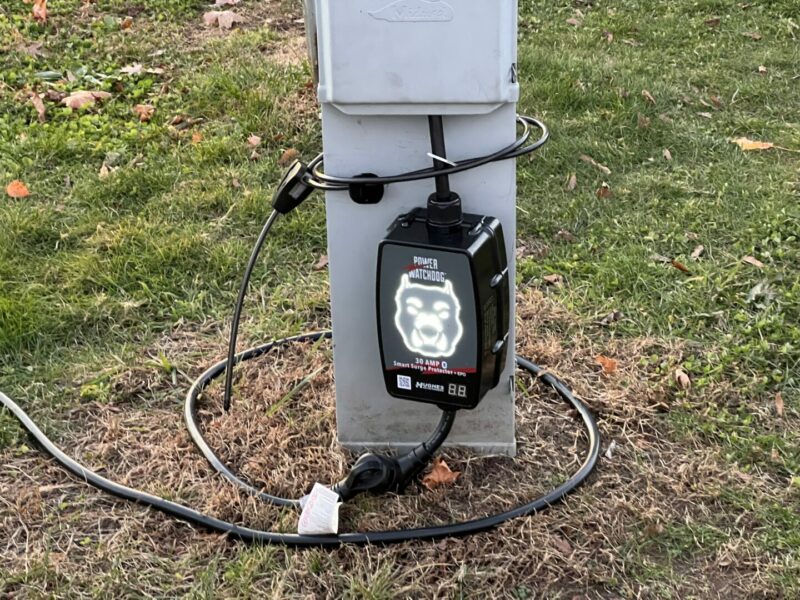Table of Contents Show
If you’re a newbie, RV electrical hookups can be rather intimidating. You’re dealing with high voltages, and a mistake could be costly or even deadly. However, if you want to power your RV and use electronics, you must understand how to do it safely and properly.
We want you to be safe and have fun on your adventures, so we’ve created our RV electrical hook-up guide for newbies.
After reading this guide and connecting your rig to power a few times, this task will practically be second nature.
Let’s get started!
What Kind of Electrical Hookup Does an RV Need?
A typical electrical hookup for an RV looks similar to what you see in residential electrical outlets, except it’s much larger.
For full functionality of your RV, you’re likely going to need a 30-amp or 50-amp electrical connection.
However, with the proper adapters and a bit of power management, you can plug an RV into a standard 120V residential outlet.
You must manage your power appropriately and not overload an outlet or power cord.
Pulling too much power can generate heat and increase the risk of a fire. Know the limits of your power cables and any electrical outlets when plugging in your RV.
RV Electrical Hookup Guide for Newbies
Safety should always be your top priority when dealing with any kind of electrical connection. Follow the steps below, and you can keep yourself and your RV safe when hooking up to power.
Steps to Connect an RV to Power
Connecting an RV to power requires you to complete steps in a specific order.
Failing to do so can be dangerous and may potentially damage your RV.
Using a checklist can be very helpful when you’re a newbie and worried about missing a step.
1. Turn Off Breaker
The first step in your RV electrical hookup to power is to turn off the breaker at the power pedestal.
Inspect the power pedestal once you turn off the breaker, especially if it looks sketchy.
Some campgrounds are better than others at maintaining their power pedestals, and you never know how the previous campers treated it.
Notify the camp host or the campground staff if there are any obvious signs of damage or safety issues.
2. Test Power Source
After checking everything out, you should connect a surge protector or energy management system (EMS).
Many RVers make the mistake of not using these protective devices when connecting their RV to power.
However, these devices can test the wiring and protect your RV electrical hookup from surges and drops in voltage.
Once you plug in your device, turn on the breaker to the outlet.
These devices often use color-coded or numeric codes if there are any issues with the connection.
Once the test is complete, turn the breaker back off.
You should test it every time you’re plugging in your RV.
You can also test the power source with a standalone tester.
- Progressive Industries 30A Receptacle testers detect wiring faults at the pedestal
- Tests the following with a single indicator: Open Ground, Open Neutral, Open Hot
3. Connect Power Cable to RV and Surge Protector
If there are no warnings or alerts from your protection devices, you can now grab your power cable.
First, connect the appropriate end of your power cable to your RV.
These are typically twist-and-lock connections that create a very tight connection between the RV and power cable.
Take the plug-in side of your power cord and plug it into your surge protector or EMS.
You can then plug it into the outlet on the power pedestal. Ensure that all of your connections are tight and pushed in all the way.

4. Turn On Power
The final step is to turn on the breaker to deliver power to your RV. Flip the switch and make sure everything goes as planned.
Check your surge protector and EMS, and make sure there are no alerts or issues before you move on to set up the rest of your campsite.
RV Electrical Hookup Tips
You should keep in mind a few things when connecting power to your RV. Let’s look at a few tips we use anytime we’re connecting an RV to a power source.
Be Prepared with Adapters
Electrical connections at campgrounds can be unpredictable.
You may have thought you booked a site with 50-amp power, but discover that it’s only 30-amp.
Having a variety of adapters can allow you some flexibility in connecting your RV to a power source.
These adapters aren’t overly expensive and are relatively small, which are perfect for storing in your RV.
- ETL Listed: RV 30 amp to 110 adapter, 15 Amp NEMA 5-15P male to 30 Amp NEMA TT-30R female adapter, 10 Gauge 125 Volt...
- Heavy Duty: Molded plug, copper wiring coated, heavy duty flame retardant, UV-resistant, STW indoor/outdoor water...
Regularly Inspect Power Cable
Your RV’s power cable can take quite a beating during your adventures.
You should regularly inspect your power cable to ensure there’s no damage to it.
Exposed wires and cuts can be extremely dangerous. If you find cuts or exposed wires for any type of electrical cable, you should replace it immediately.
Keep in Mind: An RV power cord is essential to having a comfortable RV experience. Make sure you’re up to date on your RV power cords!
Upgrade to an Electrical Management System (EMS)
Many people use surge protectors to protect their expensive electronics, including their RV.
While these are great for protecting against lightning and other unexpected surges in power, they typically don’t protect against voltage drops, which can be just as destructive.
Hot summer days can put a campground’s electrical system to the test.
Some RVs have two or three power-hungry air conditioners, which can push the power system to its limits.
With only so much power available, your power pedestal may not provide the needed energy.
That can damage sensitive electrical components in your refrigerator, air conditioner, and the other expensive electronics in your RV.
Some EMS devices can connect to your phone and send alerts when the voltage from your power pedestal changes.
Many will shut off the power supply entirely to the RV if unsafe conditions are present.
- Maintain electronic safety - This 50 Amp RV Surge Protector by Progressive Industries is a real guard for your RV...
- Prevents costly damage - With a 50A/120-240V/12,000W rating, EMS-HW50C can absorb surges of up to 3,580 joules. This...
- ELECTRONIC SAFETY FOR YOUR RV: The Progressive Industries surge protector ensures top-notch protection for your RV's...
- PREVENTS COSTLY DAMAGE: Designed to handle 30A/120V/3,600W, the EMS-HW30C surge protector offers superior protection by...
Avoid Shady Power Sources
Never connect your RV to a power source that appears shady.
Some campgrounds haven’t updated their electrical systems in decades, and it shows.
When in doubt, don’t connect.
Reach out to the staff at the campground and share your concerns with them.
They may be able to move you to a different site with a power source that’s in better condition.

Manage Your Power Wisely
Many RVers make the mistake of trying to use too much power with their RV electrical hookup, especially while running an air conditioning unit.
If you’re on a 50-amp connection, you’re likely won’t have any issues if the connection is in good working order.
You can easily run multiple air conditioners and most power-hungry electronics as needed.
However, you will have trouble if you try to blow dry your hair while making coffee and heating your breakfast in the microwave.
If you plug a 50-amp RV into a 30-amp power connection, you’ll need to be mindful of your power usage.
This is generally enough to run a single air conditioner and one other high-powered device at a time.
If you push the system to its breaking point, you’ll likely trip the breaker and need to reset it.

Can I Plug My RV Into a 110 Outlet?
You can find inexpensive adapters at almost any store that sells RV equipment that will allow you to plug your RV into a 110 outlet.
Use a heavy-duty extension cord to avoid overheating the extension cord.
This is typically enough to keep the lights on in your rig, but not much more.
Keep in Mind: Do you know how to add or replace an electrical outlet in your rig? If not, this article will teach you how!
Do RVs Need Surge Protectors?
You should always use a surge protector, preferably one with an EMS.
By not using a surge protector, you’re leaving your RV unprotected from dangerous surges and drops in voltage.
These unexpected events can destroy the sensitive electronics inside of your rig.
We strongly suggest using them every time you connect your RV to a power source.
RV Electrical Hookups Power Your Adventures
Electrical hookups make it easier to enjoy your RV when camping.
Whether you need to heat food in the microwave or run an air conditioner to stay cool, your adventures can be better because of them. While it may seem intimidating at first, you’ll be a pro in no time!
Follow the tips we’ve provided today, and don’t be afraid to ask for help when you have concerns.
Have you ever encountered a campground with bad electrical connections?
Last update on 2025-07-06 / Affiliate links / Images from Amazon Product Advertising API










